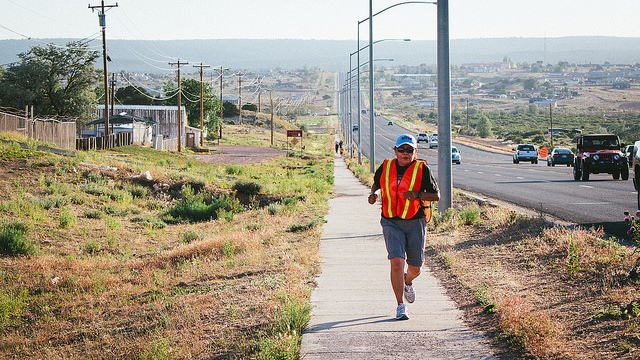Art and Culture
Navajos commemorate anniversary of 1868 treaty

FILE: A group of Navajo runners had reached a dusty New Mexico hilltop while retracing a 400-mile desert route that their ancestors had crossed a century and a half earlier. (Photo by Donovan Shortey/Flickr, CC BY 2.0)
ALBUQUERQUE, N.M. — A group of Navajo runners had reached a dusty New Mexico hilltop while retracing a 400-mile desert route that their ancestors had crossed a century and a half earlier.
That morning the runners said a prayer before heading west on their trek to Window Rock, Arizona, and Navajo Vice-President Jonathan Nez reflected on how they had grown stronger with each day, just as he imagined their ancestors might have in 1868.
That year, more than 7,000 Navajos made the same journey home to the Four Corners area of the Southwest after surviving years of incarceration at Bosque Redondo at the U.S. military’s Fort Sumner in eastern New Mexico. Conditions there were so dire and deadly that many starved and fell ill, according to multiple historical accounts. Many Navajos also died during their forced relocation, known as the Long Walk, starting in 1863.
The signing of the Navajo Treaty of 1868 signalled an end to the difficult chapter, allowing for the Navajos to return home to an area that has since become the United States’ largest American Indian reservation.
On Friday, the treaty was being commemorated on the day of its 150th anniversary in the Navajo Nation capital of Window Rock, with Nez leading a group in walking a final stretch of the long run that began two weeks ago at Fort Sumner, and remarks from tribal leaders and others. An original copy of the treaty on loan from the National Archives is on display at the Navajo Nation Museum through June.
“Our ancestors who travelled back from Fort Sumner, they were thinking of us today. They wanted something better,” Nez said. “Now, we have to think about our relatives 150 years into the future.”
He and others say they want the anniversary to mark a new chapter for the Navajo Nation, just as the treaty itself did.
The treaty the Navajos negotiated gave them 5,300 square miles within the boundaries of four mountain peaks the Navajos hold sacred. Their promises to the United States included not interfering with the building of railroads.
The treaty is among more than 300 the United States signed with tribes. It’s exceptional in that it allowed for Navajos to return to their homeland, where years earlier Christopher “Kit” Carson had carried out military orders to force their surrender by destroying crops, livestock and homes.
During the same era, numerous other tribes were forced from their homelands or saw them diminished as America expanded west. The same year of the Navajo’s treaty, for example, Sioux tribes entered into one that deeded land, including the Black Hills, to the Lakota. But the discovery of gold brought waves of settlers, and the government seized the land in 1877.
Today, there are more than 330,000 enrolled Navajos, more than almost any other tribe, and their land base is five times larger than what was originally allotted through the treaty. Their 27,400-square-mile reservation — an area larger than West Virginia — stretches across parts of New Mexico, Arizona and Utah.
In the book “Nation to Nation: Treaties Between the United States and American Indian Nations,” Navajo historian Jennifer Denetdale writes that an Army general had tried to talk the tribe’s leaders into moving even farther east to Oklahoma, known then as Indian Territory, where the government had forced the Cherokee and others. The Navajos resisted.
Generations later, their descendants’ commemoration has stirred conversation on the treaty’s continued impact, both among the runners who retraced their ancestors’ route and others.
Jaclyn Roessel, a descendent of a survivor of the relocation who escaped Bosque Redondo, said she draws personal strength and inspiration from the stories passed down through her family from the Long Walk, even as she has grown angrier in recent reflections about the treatment of Navajos at the time. In recent months, she has interviewed youth, historians and community members as co-producer of an audio documentary, “Nihidziil 150: Strength through Storytelling,” exploring the era’s significance.
“It’s not something that was 150 years ago,” she said. “It’s something I carry with me — that legacy and that strength of someone who really fought for me to be here.”





















